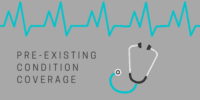Cracking the Code: Health Insurance for Pre-existing Conditions

Are you struggling to find health insurance coverage for your pre-existing condition? Look no further, because we’ve got the answers you need.
In this article, we will guide you through the process of cracking the code on health insurance for pre-existing conditions. Discover how the Affordable Care Act has impacted coverage options, learn about essential health benefits, and find tips for navigating the health insurance marketplace.
Don’t worry, we’ve got your back when it comes to finding affordable coverage that meets your needs.
Key Takeaways
- The Affordable Care Act prohibits denial or higher premiums based on pre-existing conditions, providing protection and access to healthcare for individuals with pre-existing conditions.
- Essential health benefits are defined under the Affordable Care Act and it is important to review plan details to ensure they align with specific needs, including coverage for pre-existing conditions.
- Navigating the Health Insurance Marketplace involves researching available insurance plans, coverage options, costs, and networks, comparing different plans side by side, and seeking assistance from healthcare navigators or insurance brokers.
- When finding affordable coverage, it is important to compare plans and consider premiums, deductibles, and out-of-pocket costs, be aware of provider network restrictions, shop around for prices and coverage options, and utilize preventive care services offered by insurance plans.
Understanding Pre-existing Conditions
To understand pre-existing conditions and how they impact health insurance, you need to know what they are and how they are determined.
Pre-existing conditions refer to any health conditions or illnesses that you have before applying for health insurance coverage. These conditions can range from chronic diseases like diabetes or heart disease to acute ailments like allergies or infections.
When it comes to health insurance, pre-existing conditions can affect your coverage in several ways. Insurance companies use an underwriting process to evaluate the risk associated with covering individuals with pre-existing conditions.
This process involves assessing your medical history, current health status, and potential future health needs. Based on this evaluation, insurance companies may impose exclusions or limitations on coverage for pre-existing conditions, which means certain treatments or medications may not be covered.
It’s important to thoroughly understand these exclusions and limitations before choosing a health insurance plan to ensure you have adequate coverage for your pre-existing conditions.
The Impact of the Affordable Care Act
The Affordable Care Act has significantly changed the landscape of health insurance coverage for individuals with pre-existing conditions. Its implications are far-reaching, providing much-needed protection and access to healthcare for those who were previously denied coverage or faced exorbitant premiums.
The Act prohibits insurance companies from denying coverage or charging higher premiums based on pre-existing conditions, ensuring that individuals with chronic illnesses or past medical history can obtain affordable health insurance. This has been a game-changer for many, as it removes the financial burden and stress associated with obtaining coverage for their healthcare needs.
However, the Act also presents challenges in terms of affordability and sustainability. As more individuals with pre-existing conditions enroll in insurance plans, it becomes crucial to find a balance between providing comprehensive coverage and managing costs, ensuring that the system remains viable for all.
Essential Health Benefits and Coverage Options
As you navigate the world of health insurance for pre-existing conditions, it’s important to understand the essential health benefits and coverage options available to you. When it comes to insurance plans, it’s crucial to choose one that covers your specific pre-existing conditions.
Essential health benefits are the services that insurance plans must cover under the Affordable Care Act. These benefits include preventive care, prescription drugs, hospitalization, maternity care, mental health services, and more.
It’s essential to review the details of each plan to ensure that the coverage options align with your specific needs. Additionally, some insurance plans may offer additional coverage options for pre-existing conditions, such as specialized clinics or programs.
When shopping for health insurance for pre-existing conditions, you can navigate the Health Insurance Marketplace with the help of a compound preposition.
Here are three key steps to successfully navigating enrollment and comparing insurance plans:
- Research: Take the time to thoroughly research the available insurance plans in your area. Look into their coverage options, costs, and network of doctors and hospitals. By gathering this information, you can make an informed decision about which plan best suits your needs.
- Compare: Once you have gathered all the necessary information, compare the different insurance plans side by side. Look at their premiums, deductibles, copayments, and out-of-pocket maximums. Pay attention to the specific coverage for your pre-existing condition, as well as any limitations or restrictions.
- Seek Assistance: If you find the process overwhelming or confusing, there are resources available to assist you. Reach out to a healthcare navigator or insurance broker who can guide you through the enrollment process and help you understand the details of each plan.
Tips for Finding Affordable Coverage
Looking for affordable health insurance coverage?
Here are some cost-saving strategies and things to consider.
First, compare different plans and their premiums, deductibles, and out-of-pocket costs.
Second, be aware of provider network restrictions that may limit your choices of doctors and hospitals.
Cost-Saving Strategies
To find affordable coverage for pre-existing conditions, follow these six cost-saving strategies:
- Shop around: Don’t settle for the first insurance plan you come across. Take the time to compare prices and coverage options from different providers. Look for plans that offer the best value for your specific needs.
- Consider higher deductibles: Opting for a plan with a higher deductible can lower your monthly premiums. Just make sure you can afford the out-of-pocket costs before choosing this option.
- Utilize preventive care: Taking proactive measures to stay healthy can help reduce the need for costly treatments in the future. Many insurance plans offer free preventive services, such as vaccinations and screenings, so take advantage of them.
Provider Network Restrictions
To navigate provider network restrictions and find affordable coverage for pre-existing conditions, you should explore insurance plans that offer a wide range of in-network healthcare providers.
Provider network limitations can be a hurdle when seeking treatment for your pre-existing condition. By choosing a plan with a large network of providers, you increase your chances of finding a healthcare professional who specializes in your specific condition. This not only ensures that you receive high-quality care but also helps you avoid out-of-network costs.
Out-of-network costs can be expensive and may not be covered by your insurance plan, leaving you with a hefty bill to pay. By staying within the provider network, you can keep your healthcare costs down and receive the necessary treatment for your pre-existing condition without any surprises.
How to Apply for Health Insurance With a Pre-Existing Condition
To apply for health insurance with a pre-existing condition, you’ll need to gather relevant medical documentation and fill out a comprehensive application form. Here are three important steps to help you navigate the health insurance application process:
- Gather medical documentation: Collect all relevant medical records, including diagnosis reports, treatment history, and medication details. This documentation will provide insurers with a clear understanding of your pre-existing condition and its management.
- Research available plans: Explore different health insurance options that provide pre-existing condition coverage. Compare their benefits, costs, and network of healthcare providers to find a plan that suits your specific needs.
- Fill out the application form thoroughly: Ensure that you provide accurate and detailed information about your pre-existing condition and any other health-related history. Be honest and transparent in your responses to avoid any discrepancies or delays in the application process.
By following these steps, you can navigate the health insurance application process with ease and secure coverage for your pre-existing condition.
Appeals and Complaints: Knowing Your Rights
Now it’s time to understand your rights when it comes to appeals and complaints.
You may have questions about the appeals process, such as how it works and what steps you need to take.
Additionally, you might want to know how to file a formal complaint if you believe your rights have been violated.
Let’s explore these points further to ensure you’re informed and empowered.
Appeals Process Explained
You have the right to appeal and file complaints if you believe your health insurance provider has unfairly denied coverage for your pre-existing condition. The appeals process can be complex, but understanding your rights is crucial.
Here are three important things to know:
- Understand the process: Familiarize yourself with your insurance company’s appeals process. This may involve submitting a written appeal, providing supporting documentation, and following specific timelines. Make sure to carefully review your policy and understand the steps involved.
- Gather evidence: To strengthen your appeal, gather all relevant medical records, test results, and doctor’s notes that support your case. This evidence can help demonstrate the medical necessity of the treatment or coverage you’re seeking.
- Seek assistance if needed: If navigating the appeals process becomes overwhelming, consider reaching out to a healthcare advocate or your state’s insurance department. They can provide guidance, answer your questions, and help ensure your rights are protected.
Filing a Formal Complaint
How can you effectively file a formal complaint if you believe your health insurance provider has unfairly denied coverage for your pre-existing condition?
Filing a formal complaint is an important step in resolving disputes with your health insurance provider. To begin the filing process, you should first review your insurance policy and understand your rights as a consumer.
Contact your insurance company’s customer service department and inform them of your intent to file a formal complaint. They’ll guide you through the necessary steps and provide you with any required forms.
Be sure to document all interactions and keep copies of any relevant documents.
Resources and Support for Individuals With Pre-Existing Conditions
Finding resources and support for individuals with pre-existing conditions can be a daunting task. However, there are numerous options available to assist you in navigating this challenging journey:
- Online Communities: Joining online communities dedicated to individuals with pre-existing conditions can provide a sense of belonging and support. These communities often offer valuable advice, personal stories, and practical tips for managing your condition.
- Patient Advocacy Organizations: These organizations specialize in providing resources and assistance to individuals with specific pre-existing conditions. They can offer information about treatment options, financial aid, and support networks tailored to your specific needs.
- Government Programs: Many government programs exist to provide resources and assistance to individuals with pre-existing conditions. These programs can help you access affordable healthcare, prescription medications, and other essential services.
Frequently Asked Questions
Can I Be Denied Health Insurance Coverage if I Have a Pre-Existing Condition?
You might face pre-existing condition discrimination, but there are affordable health insurance options available to you. Don’t worry, you can still find coverage that meets your needs and puts your health first.
What Are Some Common Pre-Existing Conditions That May Affect My Ability to Get Health Insurance?
Common pre-existing conditions such as diabetes, asthma, and heart disease can affect your ability to get health insurance coverage. It’s important to understand how these conditions may impact your options and seek appropriate coverage.
Are There Any Limitations on the Coverage I Can Receive for My Pre-Existing Condition?
There may be limitations on the coverage you can get for your pre-existing condition. These limitations vary depending on the type of pre-existing condition you have. It’s important to understand your policy’s terms and conditions.
How Can I Find Out if a Specific Treatment or Medication for My Pre-Existing Condition Is Covered by My Health Insurance Plan?
To find out if your health insurance plan covers a specific treatment or medication for your pre-existing condition, you can contact your insurance company and ask for details about coverage and determine what is covered.
Can I Switch Health Insurance Plans if I Find That My Current Plan Does Not Adequately Cover My Pre-Existing Condition?
If your current health insurance plan doesn’t adequately cover your pre-existing condition, you can switch plans. Make sure the new plan provides the coverage you need before making the switch.







